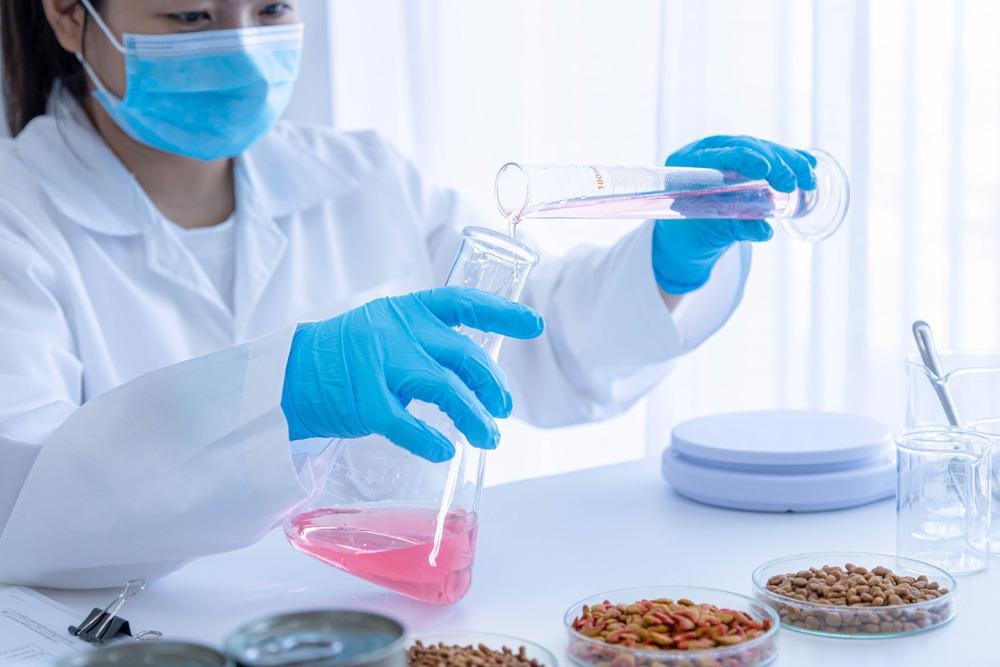Food safety analysis is a critical part of dealing with dangers to human health. At the moment, a large portion of food analysis utilizes traditional methods, which possess some drawbacks. This article will look at how electrochemical sensors can help to improve food safety analysis, discussing recent advancements in this field.

Image Credit: SatawatK/Shutterstock.com
Electrochemical Sensors
An electrochemical sensor is a device that transforms electrochemical data into a signal that can be analyzed analytically. Electrochemical sensors are composed of an analyte, a receptor that binds to the analyte, and a transducer that turns the reaction into a detectable electrical signal.
The electrode serves as the transducer in electrochemical sensors. In most electrochemical sensors, the reaction takes place on an electrode surface. The electrode will either oxidize or reduce the analyte or sample. The current generated by the reaction is used to calculate critical data such as sample concentrations.
Use of Electrochemical Sensors
Electrochemical sensors were initially used to monitor industrial oxygen. However, they are now used and developed in various applications. For example, gas sensors detect carbon monoxide; electrochemical biosensors detect illegal additives or contaminated particles in food products; heavy metal sensors for water quality monitoring; hydrocarbon sensors for measuring lubricating oil deterioration and alcohol and ketone sensors to assess motor oil degradation.
Importance of Food Safety Analysis and Challenges
Food safety and quality are critical concerns in the food sector. There is an increasing desire to protect the food chain and products from hazardous or damaging chemicals like pollutants, allergies, toxins, or infections that are dangerous for our health. Conventional methodologies are constrained by lengthy studies, costly and sophisticated procedures, and a shortage of competent employees.
Food analysis is traditionally performed at the end of the manufacturing process with the help of mass spectrometry, chromatography, and ultraviolet detection. However, these techniques have a variety of disadvantages.
First, the inspection is done at the end of the manufacturing process. As a result, contaminated objects may move through the entire manufacturing chain, or the food product can even be sold before contamination is recognized. Secondly, these are time-consuming, labor-intensive and costly techniques because they require large sample amounts and specialist workers.
Electrochemical Sensors: A Solution to the Challenges Faced in Food Safety Analysis
Electrochemical biosensors allow food items to be examined throughout the manufacturing process. In addition, where toxin accumulation generally coincides with time, electrochemical biosensors have a significant advantage in terms of speed of analysis. Fungal toxins, for example, are carcinogenic secondary metabolites that affect a wide range of foods, including nuts, cereals, vegetables, bread, dried fruit, and meat.
Electrochemical biosensors are a better option in these instances since they reduce detection periods from days to minutes. Furthermore, in situ detection improves the portability of analytic tools, which often require no training to use, and can also enable real-time analysis to be integrated into food processing systems.
Current Research and Applications
US scientists developed a graphene-based electrochemical sensor using aerosol inkjet printing. This sensor detects toxins and histamines in foods faster than standard laboratory tests. Scientists have found that the graphene biosensor can detect histamine, which is linked to headaches, diarrhea, and an allergic reaction in a person, in buffer solution and fish broth in toxicologically significant amounts; these are 6.25–100 ppm and 6.25–200 ppm with limits of 2.52 ppm and 3.41 ppm respectively.
Histamine levels in fish that exceed 50 ppm cause severe allergies in some people and even food poisoning. It is also important that the sensor demonstrates a short response time, 33 minutes, and no pre-treatment of product samples is required.
Conzuelo et al. (2013) developed an amperometric affinity biosensor to quantify and detect residues of β-lactam antibiotics. The sensor showed low ppb detection limits for tested antibiotics in raw milk and high selectivity for other antibiotic residues commonly found in milk and dairy products.
Ang, Por and Yam (2015) have developed an amperometric enzymatic electrochemical biosensor based on the immobilization of glucose oxidase on an inert chitosan membrane fixed on a platinum electrode.
The basic principle of this biosensor is the quantification of glucose by electrochemical detection of Hydrogen peroxide (H2O2) enzymatically released. The electrochemical biosensor measured the glucose content in apple, pear, mango, watermelon, and orange tissue homogenates. The accuracy was approximately similar to a commercial glucose assay kit, with a detection limit of 0.05 mM at s/n > 3.
Future Developments
Food safety is undeniably one of the major worldwide challenges. Electrochemical sensors are used to overcome this challenge as they are far less expensive and easier to miniaturize. As a result, real-time monitoring can be improved in food manufacturing, especially for dairy and brewing goods.
Electrochemical sensors will be widely adopted as a future tool for food production and safety due to the accuracy of sample analysis at all stages of the food supply chain.
Continue reading: New Miniature MEMS-Based CO2 Gas Sensor
References and Further Reading
Ang LF, Por LY, Yam MF (2015) Development of an Amperometric-Based Glucose Biosensor to Measure the Glucose Content of Fruit. PLOS ONE 10(3): e0111859. https://doi.org/10.1371/journal.pone.0111859
Conzuelo, F., et al (2013). Integrated amperometric affinity biosensors using Co2+–tetradentate nitrilotriacetic acid modified disposable carbon electrodes: application to the determination of β-lactam antibiotics. Analytical chemistry, 85(6), 3246-3254. https://doi.org/10.1021/ac303604b
Mishra, G. K., Barfidokht, A., Tehrani, F., & Mishra, R. K. (2018). Food Safety Analysis Using Electrochemical Biosensors. Foods (Basel, Switzerland), 7(9), 141. https://doi.org/10.3390/foods7090141
Parate, K., et al (2020). Aerosol-jet-printed graphene electrochemical histamine sensors for food safety monitoring. 2D Materials, 7(3), 034002. DOI: 10.1088/2053-1583/ab8919 Retrieved from: https://iopscience.iop.org/article/10.1088/2053-1583/ab8919
Disclaimer: The views expressed here are those of the author expressed in their private capacity and do not necessarily represent the views of AZoM.com Limited T/A AZoNetwork the owner and operator of this website. This disclaimer forms part of the Terms and conditions of use of this website.